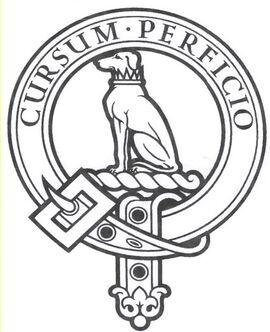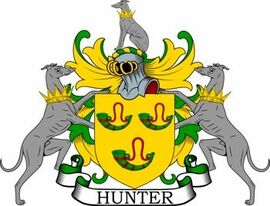Clan Hunter
Contents
Clan Hunter[edit]
Clan Hunter is a Lowland Scottish Clan. The original Clan lands are on the Firth of Clyde at Hunterston in North Ayrshire and have remained in the possession of the Hunter family since 1110.
Clan Chief[edit]
Pauline Natalie Hunter is the 30th laird of Hunterston and Chief of Clan Hunter. Madam Pauline is active in the promotion of Scottish heritage worldwide and committed to the preservation of Hunterston Castle for all future generations of the extended Hunter family.
Early History[edit]
The ancestors of the early lairds of Hunterston were Norsemen. They came to Normandy in longships with Rollo (c.860-930 AD) and conquered the region, laying siege to Paris in 911 and settling in Northern France with Rollo taking the title Duke of Normandy. Guilielmus Venator (William The Hunter) was born in Venables in northern France and is named as one of the witnesses, with Hugh de Morville, at an inquisition in 1116 by David, Prince of the Cumbrians (later King David I of Scotland) regarding lands pertaining to the Church of Glasgow. William is known to have come to Scotland from Normandy after the conquest of England in 1066. Many of the ancient Scottish lowland families have similar Norman origins. Norman Venator the 2nd laird, is referred to in a Royal Charter of King Alexander III of Scotland dated 1271 confirming that he had previously been granted lands in the Barony of Ardneil on the coast of Ayrshire by King Malcolm IV of Scotland (1153-65). Ardneil farm neighbours Hunterston land and would have been in the possession of the lairds at that time. The 3rd laird, Venator (The Hunter) was named in charters of King Alexander II of Scotland who reigned 1214-49 and John Deo Venator the 4th laird, was a witness to a deed in the Glasgow Church records of 1233.
Taking Sides[edit]
Aylmere le Huntar, the 8th laird was one of the Scottish Magnates who signed the famous Ragman Rolls in 1296, as an act of homage in submission to King Edward 1st of England. John Huntar, the 14th laird was killed at the Battle of Flodden on 9th September 1513 in the service of the Scottish Crown. Kentigern (Mungo) Huntar of Huntarstoune, the 16th laird died fighting for Mary, Queen of Scots at the Battle of Pinkie 10th September 1547. He was named after Kentigern, a 6th century Apostle of the Scottish Kingdom of Strathclyde, also known at Mungo who founded and is the Patron Saint of the City of Glasgow. His son Robert Huntar the 17th laird, also fought for Mary and was seriously wounded at the Battle of Langside (1568). Surviving, he became a supporter of the Reformed Religion (Protestantism). He died in 1581. Robert’s brother James is considered the founder of several genealogical branches of the extended Hunter family (Abbotshill, Barjarg, Thurston, Doonholm, Auchterarder and the Hunter-Blair baronets).
Hunterston Castle[edit]
Hunterston Castle consists of a cluster of buildings of different historical periods attached to the main Peel tower, representing a history of the Hunter family living and farming at Hunterston for over 900 years. The tower is the oldest section dating from the 13th century. The exact year of original construction is unknown but it likely replaced an earlier wooden structure. There is no protective moat around the building as it was surrounded by an adjacent area of marshland that was drained in the 1820s by the 25th laird to create arable farmland
Hunterston Brooch[edit]
Found whist digging drains at Hunterston in the autumn of 1826, the Hunterston Brooch is famous because of its beauty and size [4] [5]. Made of silver, partially gilded and inset with gold filigree and studded with Amber, the brooch is in almost perfect condition with only the point of the pin, some of the amber studs and all of their gold caps missing. The style and workmanship date to about AD 700 and it is considered an outstanding piece of design and craftsmanship combining both Celtic and Anglo-Saxon features in a period which artistically was a golden age in the British Isles. The original brooch is prominently displayed in the National Museum of Scotland in Edinburgh to show inscriptions on the reverse and is regarded as one of their most important national treasures [6]. It is possible the owner, a person of high status to possess such a fine object, was a victim fleeing the Battle of Largs (1263).
Royal Charter[edit]
William Huntar of Ardneil, the 10th laird was granted a Royal Charter by King Robert II of Scotland (1371-1390) signed in Stirling on the 2nd May 1374. This Charter is preserved at Hunterston with the original Royal seal intact. It remains the oldest document in the possession of Clan Hunter [7] thus consolidating their unbroken link with the lands at Hunterston. In Scotland, all lands were forfeit to the Crown in times of war. Afterward, being restored in exchange for services to the reigning Monarch. William was born in 1350.
Clan Tartan[edit]
Known as the Hunter of Hunterston Sett [8], the design for our Clan tartan was chosen to incorporate a green hunting base with blue representing the proximity of Hunterston to the sea. The narrow gold (yellow) stripes signify the Chief’s appointment as Royal Huntsman and red is taken from the lanyards of the hunting horns in the Chief’s coat of arms.
Industrial Activity[edit]
Following the construction of a Nuclear powered electricity generating plant on Hunterston land in 1954, the area has become synonymous with industrial development. This continues today to impact the small area of original Clan lands remaining in the possession of the Hunter family.
Clan Hunter Society[edit]
Set up in 1983, the Clan society [11] extends interest through branches worldwide to all those of Scottish Hunter surnamed descent. A regular presence at highland games and other Scottish cultural events is supported by the voluntary membership.
Links[edit]
www.clanhunterscotland.com
www.facebook.com/clanhunteruk





